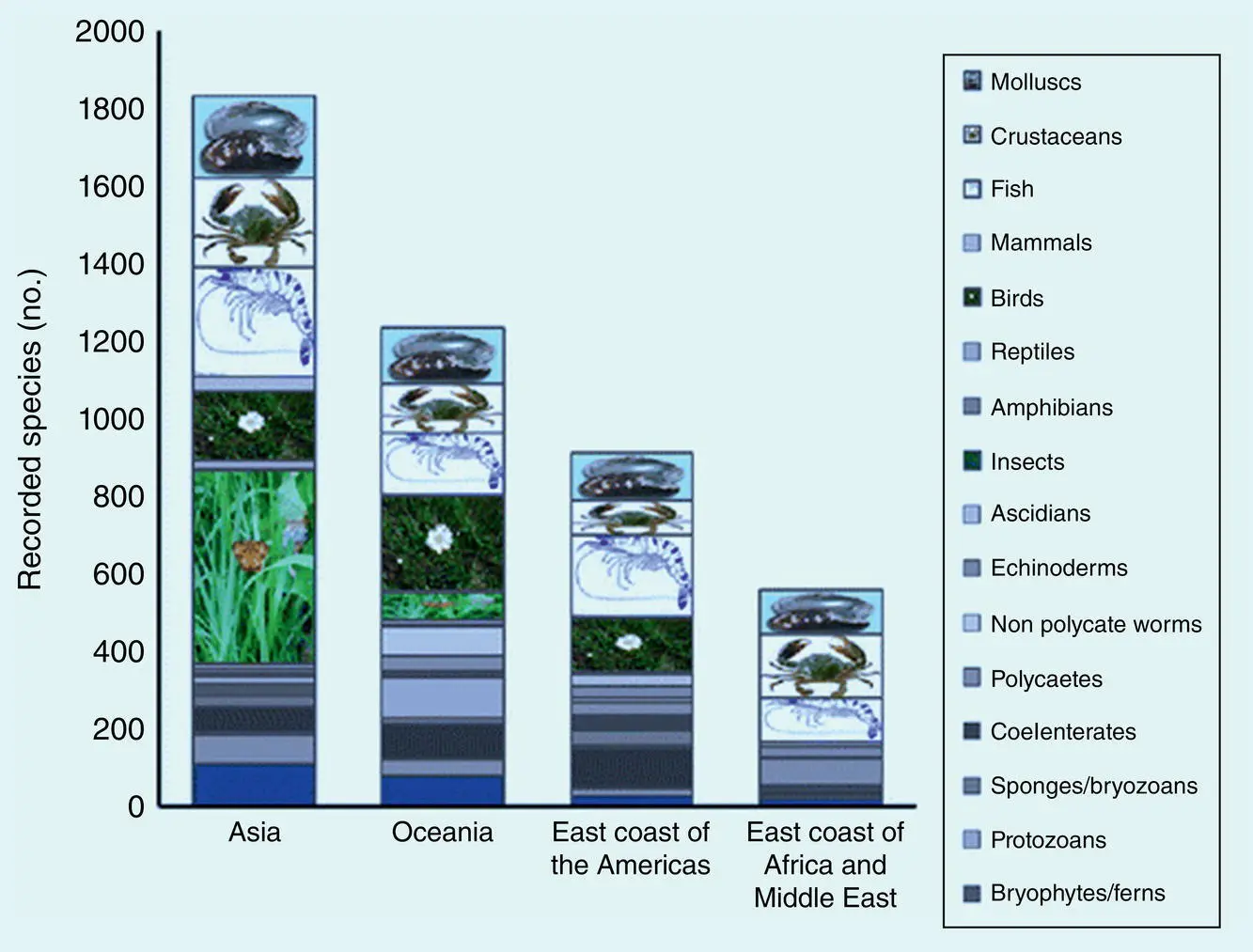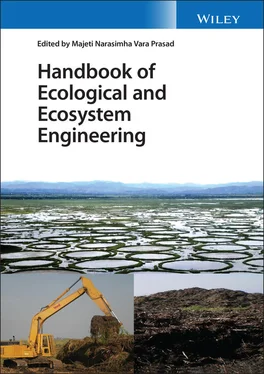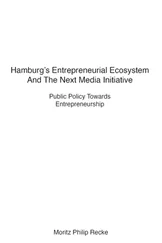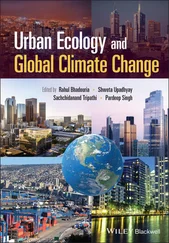Mangroves are intertidal forests along the shorelines of tropical regions, submerged under seawater most of the time and physiologically adaptable to saline water. The trees have special adaptations in their roots that let them survive in soft muddy soil and transport oxygen from the atmosphere to their roots in anaerobic conditions. Reproduction is supported by the unique nature of their seeds, which can float on water and are transported to other sites.
Mangrove forests naturally stabilize shorelines by reducing tidal currents and wind energy hitting the shore. They provide food and shelter to the coastal fish and shellfish colonies; habitat for various species of sea birds as well as wading birds; and timber, medical products, and useful chemicals ( Figure 3.2). In spite of being home to a wide range of flora and fauna, mangroves are often considered worthless swamps and have been destroyed by hydrological impacts over the years. A major reason for mangrove die‐backs is annual hypersalinity variations caused by rainwater and freshwater flow. Although mangrove forests are known to undergo self‐repairing or secondary succession every 15–30 years; they can perform this self‐sustenance only if the tidal hydrology is not disturbed and the flow of floating seeds is not interrupted.
The need to restore mangroves was only been realized toward the end of the twentieth century. Traditional ecological restoration of these forests initially aimed at rehabilitation or management of natural resources such as planting timber‐producing trees. However, this approach is not the same as an ecological restoration process. For ecological restoration of mangrove forests, several aspects must be taken into consideration: a cohesive ecosystem, alternate stable state of the ecosystem, and development of a new ecosystem once the ecological threshold is crossed. Although a complete restoration of mangroves may not be practically viable, the objective is to minimize the difference between the undisturbed (may be naturally disturbed) and restored states of the ecosystem that correlate to the principle of [3, 48]. Common manipulation practices exercised during restoration to revitalize the ecosystem primarily include the following:

Figure 3.2 Schematic representation of the geographical distribution of mangrove biodiversity.
Source: Adapted from Biswas et al. [3]. © 2009, Springer Nature. See colour plate section for colour representation of this figure .
Structural manipulation: Tree planting and hydrological engineering designs
Compositional manipulation: Seeding and planting numerous species, enhancing diversity and habitat recovery
In addition to trees, land, and water, humans are considered the fourth component of the mangrove ecosystem due to their undeniable interference in most parts of Southeast Asian countries. Therefore, ecological engineering principles can be further manipulated by incorporating significant social and economic issues related to coastal environments and ensuring active participation by local communities along with supporting their livelihoods.
3.4.3 River and Wetland Restoration
Rivers and other bodies of water (ponds, lakes, streams, waterfalls, etc.) are source of freshwater and support human and animal life on earth. A clean, self‐sustaining natural water system plays a vital role in ecological and socioeconomic development. With increasing population and thereby an increased pollution load on the environment, the sustainability of these natural services is of great concern. Thus, restoration of rivers and streams has attracted the attention of ecologists worldwide. This field is a booming enterprise and has received huge investments; it is reported that the US has spent billions of dollars on river restoration [30, 41].
Even though the importance of river restoration is understood, there is a gap between this consensus and the successful implementation of projects, which becomes evident from the rapid deterioration of freshwater sources. The restoration method selected must be based on several conditions regarding the particular river, such as geographic location, length/size, area covered, extent and nature of existing damage, stakeholder requirements, and the goal of the process. Palmer et al. [42] have proposed five standard criteria for monitoring the successfulness of ecological river restoration:
A dynamic ecological endpoint is identified in advance and used to guide the restoration.
Ecological conditions of the river are measurably enhanced.
The river ecosystem is more self‐sustaining than prior to restoration.
Implementing the restoration does not inflict irreparable harm.
Some level of both pre and post‐project assessment is conducted and information made available.
Questions may arise, such as what kinds of indicators to select that will be significant, repeatable, and reasonable for successful project evaluations. However, indicators may vary from the re‐establishment of a species to multispecies community restoration, depending on the predefined goals. There are two perspectives for selecting suitable indicators: one focuses on improving water quality as compared to the pre‐restoration state (i.e. moving away from the degraded state), while the other demonstrates how close the water quality is to that of a reference site (i.e. approaching the predetermined desired state) [42]. In this context, the chosen indicators must be easy to measure; be susceptible to changes in the system; display clear, predictable responses to such changes; and also be integrative. Jansson et al. [22] discussed the outcomes of implementation and practice of river restoration programs at the international and national levels to evaluate the understanding, accomplishments, and advancement of river restoration services.
Recently, a paradigm shift has occurred, such that river restoration design and construction imitate natural structures such as channelized streams without interfering with biomes, 7 i.e. biomic restoration is greatly harnessed by biogeomorphic agents as nature's river restorers [64]. This approach is referred to as biomic river restoration . Biomic rivers are known to be resilient to adverse effects and are true examples of sustainable management or restoration solutions that reflect the future of river restoration projects. Figure 3.3shows a section of Nippersink Creek (Illinois, US) being filled in to allow efficient farming by excavating a channel, contouring the banks, anchoring mats to control erosion, adding a mulching blanket and seeds to encourage native vegetation, and planting aquatic plants. The project is a perfect example of river restoration with multiple goals such as reduction of flooding downstream; improved water quality; habitat for fish, wading birds; and waterfowl; and involvement of youngsters in the process.
Wetlands are shallow‐water ecosystems that include marshes, bogs, vernal pools, and seagrass beds. These are also described as functions and services with broad ecological interest that serve as melting pots for public and private services promoting both consumptive and non‐consumptive assistance. Wetlands are considered a perfect example that integrates the approaches of two diverse fields – natural science and social science – thus enabling the economic validation of policy development and research [56]. For economic validation, however, ecosystems are subdivided into small sets that can deliver functions and services since it may not be possible to include the entire ecosystem during validation with standard methods.
Читать дальше













